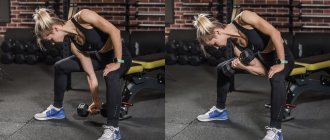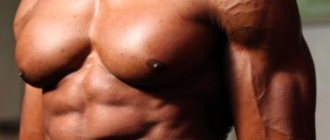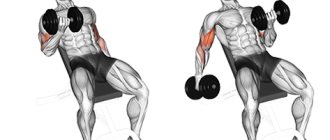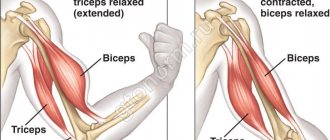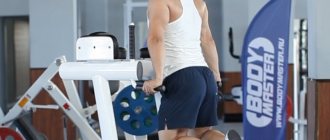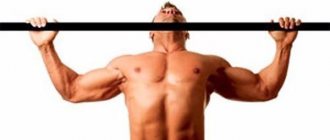The size of the biceps plays an important role in an athlete's figure. To achieve significant results, you need to not only work hard on developing your biceps, but also choose the right exercises for this purpose. Every beginner in bodybuilding needs to take into account that biceps look good only when the rest of the body muscles are pumped up and well developed . The biceps should have a size proportional to the rest of the muscles. You cannot focus exclusively on training the biceps at the expense of the rest of the muscles. All muscle groups should be worked out equally, and exercises for the biceps, which place the load primarily on it, should become part of the athlete’s overall training.
Performing training to develop biceps at home
The conditions under which novice bodybuilders train vary. Not always and not everyone has the opportunity to visit the gym. Not having access to a gym doesn't mean you have to stop working out altogether. There are many exercises that you can do at home without any problems. These include push-ups.
This exercise is aimed both at working the biceps and using the muscles of the chest, arms and shoulder girdle. Its implementation does not require large free space or special sports equipment. To increase the load, if such a need exists, a backpack is put on the back, in which a load is placed.
Biceps: Introduction
Biceps are one of the favorite muscle groups of almost any bodybuilder.
Well, tell me: who hasn’t admired the size of Arnold Schwarzenegger’s biceps? Yes, almost every guy who comes to the gym. Why is this so important for a man? Perhaps this comes from the past, when strong hands helped our ancestors in hunting. The second is aesthetics, you will agree: strong hands make a man beautiful. By the way, according to various sources, the size of Arnold’s biceps was: 52-56 cm. Impressive, isn’t it?
Weight training
Exercises with dumbbells allow you to pump up your biceps as simply and effectively as possible. You can perform them both in the gym and at home.
Dumbbell Curls
Performed using regular dumbbells. They give maximum results if done on a chair. The exercise is very simple:
- sit on a chair;
- take dumbbells;
- bend and then straighten your arms at the elbows, holding weights (dumbbells).
Beginners are recommended to perform 8 to 12 repetitions. When the repetitions are easy, the weight of the dumbbells needs to be increased. The number of recommended approaches is 3 times.
The arms are bent as you exhale, and extended as you inhale. You can do the exercise with different hand positions. They can be suspended, with the elbow resting on the upper thigh or knee. Positions can be alternated. The main thing is to bend and straighten your arms at a slow, not a fast pace. If this “rule” is not followed, the biceps will not be subjected to the maximum amount of stress.
The exercise is quite simple, but effective. Raising dumbbells with your hands from a sitting position fully engages the desired muscle, works and trains it.
Hammer lift
Aimed at pumping and shaping the lateral part of the biceps, performed with dumbbells:
- stand up straight;
- hands with weights - dumbbells are lowered to the sides;
- fingers turn towards the hips;
- dumbbells, changing hands, are lifted to the shoulder.
The number of repetitions is similar to the previous exercise (8-12), and the approaches are 3.
To perform a hammer lift correctly, you need to ensure that your legs do not spring, your back remains straight, and your elbows do not lean forward. The load should be directed exclusively at the biceps muscle. When one arm is raised, the other is tense and slightly bent at the elbow.
The hand is held in the extreme position for a second or two. If the exercise is not easy, it is permissible to slightly arch your back. It should be taken into account that throughout the entire exercise it should be fixed in one position. You need to look in front of you, not down or up.
You can raise your hands alternately or both at the same time. In the latter case, the load will increase. Regardless of this, it is necessary to ensure that the dumbbells are pushed out solely by the force of the hands, without the help of the torso or legs.
The hammer lift is an exercise that is suitable for both experienced athletes and beginner bodybuilders. The “hammer” trains both the biceps and promotes the uniform development of the brachioradialis muscles. Thus, both of these muscle groups look proportional to each other.
Why don't my biceps grow?
There are quite a lot of reasons. Let's look at the main ones.
Exercising too often
If you think that the more often you train your biceps, the bigger they will be - no. The gym is full of such “personnel”. Previously, and maybe even now, they were called “snowdrops.” The type of guys who only trained biceps and abs. Do not expect biceps growth in this case: due to the state of overtraining, there will be no progress. It is also worth remembering that muscles grow during rest, not during training.
Poor nutrition
Perhaps this item will compete with the first for a leading position. The most common reason why your muscles aren't growing is because you don't eat enough. How can muscle tissue be built without the proper amount of proteins, fats and carbohydrates? That's right, no way. You don’t have to eat with pots and pans; make a smart meal plan. Snickers, chips, Fanta - tasty, but useless for creating titanium arms.
Need a meal plan to suit your goal? Write through contacts or messengers.
Worse than incorrect technique is monotony of exercises.
Be sure to learn the technique for each exercise you plan to do. Alternate exercises during your workouts. Alternate dumbbells/barbells.
Bad genetics
This is a factor that should frustrate a professional bodybuilder. The average person is capable of building voluminous biceps, but it takes effort. In bodybuilding, the main thing is discipline both in training and in life: proper nutrition and recovery.
Training on the horizontal bar
When you have this sports equipment in your yard or at home, doing pull-ups on it will be an excellent exercise for developing your biceps. Pull-ups can be done with either a reverse or direct grip. To get a noticeable result, you need to do at least three approaches. The number of repetitions in each approach varies from 10 to 15 times.
You should increase the load only when pull-ups begin to be easy. This can be done by placing additional weights on your feet or increasing the number of repetitions. To get the most out of pull-ups, keep your arms fully extended.
What newbies face
The main question for beginners is how to quickly build up biceps? But, only troubles happen quickly! Any progress takes time. You can inject a pharmacological drug into the muscle, and for a while you will get ideal forms. But in the end, under the skin there will be just an elastic mass, not muscles. And if there is the slightest violation of sterility during the injection, there will be a large abscess instead of the biceps, and everything will end in surgical intervention.
Muscles cannot grow quickly, except in cases of powerful artificial stimulation. It is given by the very drugs that you will need to sit on constantly, killing your body.
Therefore, when looking for information about biceps, how to quickly pump up these muscles, etc., you should not pay attention to supposedly magical remedies. It is much wiser to cool your ardor a little and come to terms with a gradual but qualitative increase in mass. After all, we want to not only increase its volume, but also make it stronger, right?
This means that there is only one way left to achieve our goal - to swing on our own, using the maximum potential of our body.
The information below will help you make your biceps grow as quickly as possible naturally. At the same time, the advantages are obvious: the muscles retain their volume and shape longer after stopping exercise, there is no harm to the body.
The second problem that beginners face is overestimating their own capabilities at the initial stage. The guys are in a hurry, trying to lift heavy weights on their biceps. The technique is lost, the quality of the exercises tends to zero. Progress stops.
The third problem is the lack of technology. Ideally, it would be nice for a trainer to show you how to do the exercise correctly and watch you. To do this, you need to take personal training from him. But not everyone has this opportunity, and most people start training on their own.
Another problem on which we will end the list is the desire to have super huge biceps - like those of top bodybuilders. Let us repeat that this super-result can only be achieved through unnatural means and hours of daily training. Are you ready to live in the gym and stuff your body with drugs? Let's be a little more modest, you're the Hulk.
To solve all these problems, you need to be patient and study the exercise technique and the laws of working in the gym. Go!
Biceps training in the gym
You can build up your biceps much faster in the gym. This is due to the fact that a bodybuilder has the opportunity to do many more exercises, rather than three or four. A special role in this is played by the exercise equipment and devices that are available to the athlete in the gym. They allow you to work both on individual parts and on the entire biceps muscle.
The trainer will always tell the novice athlete how to create an effective training, and will also provide support when performing difficult exercises. If doing a concentrated lift to develop biceps with maximum weight at home is dangerous, then in the gym this exercise can be safely included in the training program.
It is possible to effectively work out muscles only when the exercises are done without cheating, that is, sacrificing technique in favor of the number of repetitions.
Standing barbell raises
The gym is a great place to lift heavy weights. Raising it at home is not recommended. When there is no experienced coach nearby, there is no one to insure the athlete. In the gym there is no such problem and you can lift the maximum weight without the risk of injury.
The standing barbell lift is a basic biceps exercise and is considered the most effective for increasing both volume and strength:
- take the barbell with an underhand grip, placing your hands shoulder-width apart;
- lift the sports equipment by contracting the biceps.
If a bodybuilder tries to lift the barbell as high as possible, his arms will move forward. This should not be allowed, since the load will be transferred to the delta and will not be placed on the biceps.
Incline Bench Curls
To perform the exercise, sit on an inclined bench and take dumbbells in your hands. The back is pressed against the backrest, the legs are pressed against the floor surface. Bending your elbows, they are lifted one by one. When the arm is raised to the maximum, the hand is turned towards itself as much as possible. The main thing is that your elbows do not lean forward.
EasyFitness Denis Semenikhin - Training. Biceps (detailed)
Lifting the barbell on a Scott bench
The barbell is grasped with a medium reverse grip, which allows you to best work the biceps muscles. Keeping your shoulders on a support allows you to focus the entire load on the biceps. The exercise works most effectively on the lower biceps. In cases where an athlete experiences severe tension in the area of the wrist joints, it is permissible to replace a barbell with a regular bar with a projectile with a figured one. Another alternative option is to use dumbbells.
The exercise is performed in 3 approaches. Each one has from 8 to 12 repetitions.
Training on a bench and with a barbell can be performed without exercise equipment. To achieve quick results and maximum benefit from exercises, if you have the opportunity to use these devices, you should definitely use them.
How to train properly
Having mastered the technique of performing each exercise, we will learn what to do next with these options - what and how much to do, depending on the goals.
How many repetitions to perform and what weight to choose?
- In order to gain weight, preference should be given to exercises with free weights - barbells and dumbbells. Optimal number of repetitions: 8-12. It is important to perform each approach to failure, that is, until the muscles feel a burning sensation and are completely tired by the end of the approach. The weight of the weight in this case will be 60-80% of 1 RM. That is, if you can lift a biceps barbell with a weight of about 50 kg at one time, then the work on the mass will be 60-80% of this weight. But the weight is also selected experimentally.
- To increase strength, a set of 4-6 repetitions is suitable. Free weight exercises are also needed here, but not those in which the biceps are completely isolated, but those where cheating can be used. Such strength exercises will be safer. For strength, a weight of 80 to 90% of 1RM is used.
- For relief and sharpening the peak of the biceps, as well as for weight loss, you need to perform 14-20 repetitions. In this case, both heavy and isolation techniques are suitable, including: concentrated curls, variations on the Scott bench and crossover. This weight can be selected experimentally so that at the end of a multi-repetition approach you feel a burning sensation and fatigue in the muscles. But at the same time, the weight for such a load will be approximately 30-50% of 1 RM.
How many approaches should I do?
- To increase mass, 3-4 approaches will be enough.
- For strength – 5-6 approaches.
- For weight loss and relief, the same – 3 or 4. But depending on the training style and the number of exercises, for example in CrossFit or circuit complexes, you can use from 5 to 10 sets.
Exercises on simulators
A training complex for pumping up biceps will be complete if it includes muscle development using exercise machines. This will greatly increase your training productivity.
Arm curls on a machine using a lower block
- stand in front of the exercise machine;
- take the handle of the lower block with a reverse grip;
- bending your elbows, pull the handle towards your shoulders;
- return to their original position.
To ensure that the entire load is placed only on the biceps muscle, the elbows are pressed to the body. An alternative option would be to use ropes. Bent fingers, if the exercise is performed on ropes, should be directed towards each other.
Crossover bends
Standing straight, feet shoulder-width apart. Hands grasp the handles of the projectile and pull them to the top of the head. When the arms are extended, they should remain tense and the load should not drop completely. When inhaling, the arms are extended, and when exhaling, they are bent. The recommended number of repetitions is 8-12 times. Approaches are done from 1 to 2.
Most often, crossover curls are performed as a final exercise.
Selection of optimal projectile weight
- If you can easily do the maximum number of repetitions required for a particular exercise, or even more, then you should increase the weight of the apparatus;
- If you are unable to get close to the lower limit in the number of reps required, then you are using too much weight. Reduce it and perform quality work with optimal weight;
- Add weight only if you can confidently perform the maximum number of repetitions required for a given exercise with the working weight. For example, if you did 8 reps on a 6kg dumbbell curl, then pick up the 8kg dumbbells and keep going.
If you can’t even do 4 repetitions with the new weight, then you obviously rushed to increase the weight, overestimating your capabilities. Go back to the old weight and work with it for a while.
There is nothing wrong with trying to lift more and more weight. The main thing is to do it wisely.
Recommendations for an effective biceps workout
The key to success lies in properly organized training. This allows you to avoid both injury and excessive fatigue. If an athlete goes to the gym every day, exercises to pump up the biceps are performed every other time. A “day off” allows the muscles to recover.
You should start exercising only after warming up. Otherwise, there is a high probability of tendon rupture. If an athlete feels the need to focus exclusively on biceps, such training should be carried out no more than once a week.
Intense training cannot be done every day. The athlete must take a one-day break from training. You can devote it to visiting a sauna or Russian bathhouse.
Igor April 1, 2016
Increase the load
In order to start the process of muscle growth, you must increase the working weight of the equipment. The fact is that the body skillfully adapts to monotonous loads, which stops muscle growth. You need to shock the muscles so that they take the path of progress and development.
It is important to remember that the load must be increased gradually to avoid the possibility of injury.
If you follow this advice and remember to eat right, your muscles will definitely grow. This rule applies not only to the biceps, but also to all other muscle groups.
How to pump up your biceps to gain mass
It is important to understand that the issue of pumping up biceps is not so much doing physical exercises, but rather a combination of key conditions and factors:
- Proper nutrition with a calorie surplus and sufficient intake of amino acids from protein foods.
- Muscle recovery.
- Control of training volume by week or cycle in the program.
One of the most popular mistakes is excessive attention to working out the zone and the desire to get quick results. Athletes want to see the results of their efforts and train their biceps at least 2 times a week. Moreover, the biceps takes part in other exercises, especially deadlifts. As a result, athletes overtrain and stifle their muscle growth potential.
It is important to remember that biceps “do not like” processing. Like other areas, the biceps muscle needs rest.
Another aspect worth paying attention to is the operating mode. Some athletes get significant growth from high-repetition training and pumping, others from powerful strength work for 5-8 repetitions per set. It is impossible to predict which regimen will be best for a particular athlete. This needs to be determined experimentally or a laboratory analysis done to determine the ratio of fast and slow muscle fibers in the biceps (which for most people will be unreasonably expensive and unnecessary).
Recommendations for classes
- All of the listed exercises are performed in concentration. Movements should be smooth, without jerking or “cheating”. Try to maintain your posture, do not fall back or lean forward. So the help of other muscles for isolated biceps will be minimal.
- When training your biceps, you should pay attention to technique. The range of movements should not be stingy.
- For proper execution, the best option would be to work with a light weight that would allow you to perform 12-14 repetitions.
- When performing curls with dumbbells, at the top point of the amplitude you should supinate (turn the hand).
- When working on biceps, a very effective way to train is to use drop sets.
- Don't forget to stretch your muscles after your workout.
Also read: How to measure biceps volume? Why don't my biceps grow? How to increase the peak of your biceps?
Rotations of the arms at the forearm
This exercise for the forearm muscles involves the biceps, brachioradialis, and pronator carpi muscles. A formative exercise, used to thicken the outer and inner parts of the forearm. Recommended for everyone at the end of a biceps workout.
Exercise technique
1. Collect the required weight on the pendulum. Kneel in front of the bench and place the forearm of your working hand across it. The wrist is behind the edge of the bench. 2. In the starting position, your shoulders are straightened, your back is straight. The body is motionless until the end of the approach. The working hand holds the pendulum by the lower edge of the handle in a vertical position, the second hand rests on the bench. 3. Take a deep breath and, holding your breath, rotate your forearm with the pendulum outward (supination) so that it assumes a horizontal position. 4. As soon as the lowest point is reached, immediately, slowly return the pendulum to the vertical position. 5. You can exhale after overcoming the most difficult section of the amplitude. 6. At the moment when the pendulum returns to the top point, also do not linger. Inhale again, hold your breath and smoothly rotate the handle inward (pronation) until it reaches a horizontal position. 7. Perform the prescribed number of repetitions on one arm, then on the other. This will be one approach.
Technique tips
- Throughout the entire approach, do not lift your forearm off the bench. Once this happens, the biceps, brachialis and brachioradialis muscles take on most of the load.
- In the starting position, the wrist should be extended beyond the edge of the bench far enough so that at the lower points of the amplitude of movement, the pendulum does not touch the bench.
- There is no point in using too much weight in the exercise. It will prevent you from rotating your forearm through its full range of motion, which will significantly reduce the effectiveness of the exercise.
- However, too much weight at the bottom of the exercise can put excessive force on the wrist and dislocate the arm at the elbow.
- A variation of the exercise with a collapsible dumbbell is possible. Having collected the necessary weight at only one end, it will serve as an excellent replacement for a pendulum.
Superset: French press + close grip bench press
These exercises will perfectly pump up your triceps.
French press
Technique:
- We lie down on a bench and take a barbell with a curved bar with a narrow grip.
- We hold the barbell with straight arms, and then begin to bend our elbows, lowering the bar to the top of our forehead.
- In the upper phase, the bar should be slightly tilted back so as not to load the joints.
Close grip bench press
Technique:
- We lie down on a bench and take a barbell with a curved bar with a narrow grip.
- With a powerful movement we push the barbell up.
- We move our elbows along the body, lower the barbell onto the solar plexus, and not onto the chest.
It is recommended to do four supersets and perform each exercise 8-15 times.
How to gain muscle mass if you eat and don’t gain weight?
We pump up the back and biceps. Training for those taking their first steps in fitness
